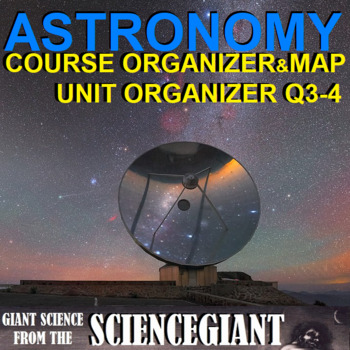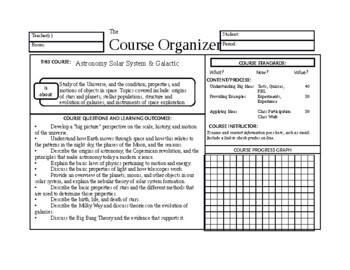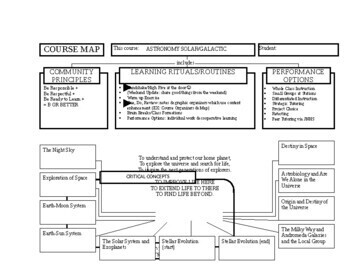StayGiant Astronomy Course Organizer and Map, Unit Organizer for Q3-4
- Word Document File
Also included in
- Teachers use the Strategic Instruction Model (SIM) Concept Enhancement Routines to transform abstract main ideas and key topics into a concrete representation that helps students think about and talk about the key topic and essential related information. SIM is about promoting effective teaching andPrice $49.70Original Price $71.00Save $21.30
Description
Begin with the end in mind! The Course Organizer and Unit Organizer Routines are teacher friendly templates for content enhancement of Astronomy and Space Science. Plan out the scope, sequence, and syllabus for state standards, learning goals, mind maps, and essential questions in an easy editable Word file, and a quarterly calendar for instruction.
Semester 2
Quarter 3:
- Life in the Universe
- Star Stuff
- Our Star
- Surveying the Solar Neighborhood
Quarter 4:
- The Bizarre Stellar Graveyard
- Our Galaxy
- A Universe of Galaxies
- The Birth of the Universe
- The Fate of the Universe
Course Organizers Routines provides a strategic instruction method to map out both semesters of the entire course, and share that lesson planning with students. Ss can then measure their progress throughout the course, preview the big questions and concepts that they will encounter.
Unit Organizer Routines provide the critical information in a unit in a way that shows the relationships between the content. The Unit Questions frame the learning for Ss, thus provides Ss with a method of self-assessing their learning. Major topics, concept maps based on standards from NGSSS for Science, and essential questions are proposed. Throughout the unit Ss add information learned to the expanded map, and at the end of the unit can use it as a review tool. With regular and consistent use, Ss scored an average of 15 points higher on unit tests.
As Benjamin Franklin supposedly said, “If you fail to plan, you are planning to fail.” This product is in Microsoft Word .doc form so that Ts can customize it to fit the needs of their Ss, schools, and school year. So modify as necessary, because YMMV.
Ts use the Strategic Instruction Model (SIM) to promoting effective teaching and learning of critical content in schools. SIM strives to help teachers make decisions about what is of greatest importance, what we can teach students to help them to learn, and how to teach them well.
Through use of the Course Organizer Routine, a teacher helps students understand the "big picture" of the course and how units fit within it. The routine helps teachers launch a course and create a learning community, including identifying critical concepts that will be central to understanding the course content, establishing rituals that will be used throughout the course to guide discussions and learning, agreeing on values that serve as the basis of classroom interactions, and introducing the ways the teacher and students will communicate about progress throughout the course.
Studies show that the use of the Course Organizer Routine helps teachers and students keep the big ideas in mind and focus their attention to understand important relationships. Instruction results in learning more about the big picture and less in trying to cover large amounts of information.
Through use of the Unit Organizer Routine, teachers can "frame" a unit to enable students to understand the "road map" of the unit. Use of the routine helps students understand how the unit fits within a course or sequence of units, see a method for organizing knowledge, define relationships among pieces of information, understand what they are expected to do, monitor their progress, and recognize what they have learned.
Students of teachers who regularly and consistently used the Unit Organizer Routine scored an average of 15 percentage points higher on unit tests than students of teachers who used it only irregularly.
#StayGiant and stay up on my new resources and STEM news. Look for the green ★ star near the top of any page within my store and click "FOLLOW". Or follow @TheScienceGiant Twitter. Stand on The Shoulders of Giants, and together we'll see further, inspire students, and enlighten inquisitive minds!






